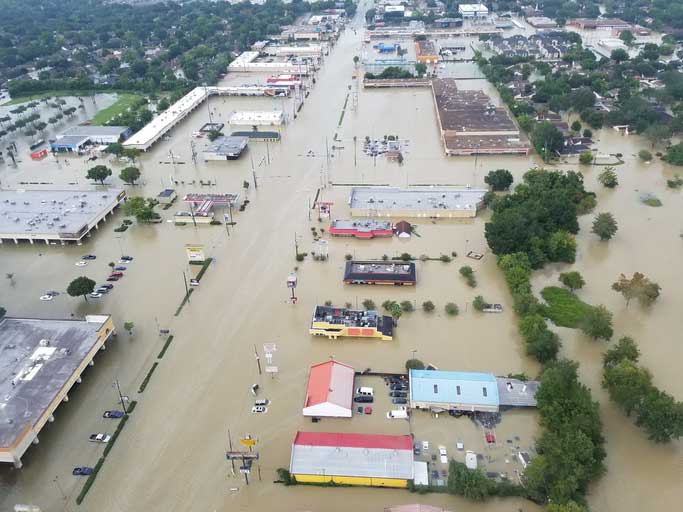- Home
- Loss Control
- Loss Control Insights
- How to Prepare Underground Storage Tanks for Flooding (updated April 2022)
Convenience stores are everywhere and often open around the clock. That makes them convenient for consumers, but it also makes them vulnerable to a variety of weather-related disasters. Flooding events are especially dangerous when it comes to maintaining the integrity of your underground storage tanks (USTs).
What Happens to USTs During a Flood?
Underground storage tanks contain both fuel and air within a closed system. This becomes a problem when the space around the tank fills with water from a heavy rain event, hurricane or river overflowing its banks. Imagine holding a beach ball underwater—it wants to rise to the surface. Similarly, the air in a UST makes the tank buoyant, pushing up against the ground to rise above the water. In a worst case scenario, the tank can pop out of the ground, compromising the entire system and causing a fuel release. Tanks may shift underground, creating cracks in the tank or the piping that can cause a release once operations resume. Other damage can include erosion and scour, product displacement and damage to the electrical system.
Many areas of the country that weren’t prone to flooding in the past are experiencing changing weather patterns, so it’s more important than ever to fortify your operations against flooding which can disrupt your business long after the water has receded.
Customize UST Installation to Prevent Damage During Flooding
If your UST is located near water or low-lying areas, you can help prevent flood damage by increasing the burial depth of the tank or adding additional pavement on top. The additional weight can help a tank from floating. You can also use special anchors to help hold the tank down. Consider adding additional automatic shutoff valves and vent pipe extensions. Always review the recommendations of the tank manufacturer and local soil conditions when planning UST placement.
Protect Your Underground Storage Tank When Flooding is Imminent
Many flooding events have advance notice—from a few hours for heavy rain events to days for hurricanes. Put together flood mitigation plans in advance so your managers and employees can use that time as effectively as possible. Plans should be easy to understand and training should be provided.
To prevent tank displacement or water entering the system, the Environmental Protection Agency (EPA) recommends these precautions:
- Turn off electricity to UST system
- Take product inventory and water level reading of all USTs to account for product loss
- Fill the tank as much as possible (with fuel, not water) to weigh it down
- Secure all openings on top of the tank as tightly as possible to prevent product release
- Ensure the seal on spill bucket plungers are operational
- Close the shear valve on pressurized piping
- Temporarily cap off vent pipes
- Place a dumpster, sand bags or large containers of sand/rock over the tank to prevent floating out of the ground
Bring Your UST Back Online After Flooding
Depending on your site-specific situation, you may take the following actions once the water has receded and local officials allow re-entry:
- Make sure the power is off to any UST-related equipment
- Determine if product leaked from the UST
- Determine if water/debris entered the UST
- Inspect the electrical system and return power to the UST
- Check release detection system for proper operation
- Check all equipment including pumps, shear valves, fill pipes and vent lines
- Clean and empty spill buckets and sumps (including those under dispensers and above tanks); inspect piping and fittings for damage
- Perform a UST system tightness test before adding product
- Test spill buckets and sumps
- Test cathodic protection
If you’ve had a tank float out of its excavation, or if you operate a remediation system that has been flooded, consult the EPA’s UST Flood Guide for information. You can also contact your storage tank authority or the National Response Center (NRC).
Find More Online
EPA – Underground Storage Tank ResourcesEPA – Natural Disasters and Underground Storage Tanks
EMC – Underground Storage Tank Management Program Template
Get in touch
Need help? We’re here for you! Whether you have questions or need personalized assistance, your local office is ready to support you.
Loss Control Insights
Stay informed with the latest news and receive actionable safety tips, all carefully curated by our team of experts.
